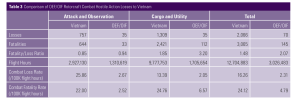-
Please take a moment and update your account profile. If you have an updated account profile with basic information on why you are on Air Warriors it will help other people respond to your posts. How do you update your profile you ask?
Go here:
Edit Account Details and Profile
You are using an out of date browser. It may not display this or other websites correctly.
You should upgrade or use an alternative browser.
You should upgrade or use an alternative browser.
Hot new helicopter/rotorcraft news
- Thread starter Randy Daytona
- Start date
Agreed. Yup, that was the USAF’s argument to Congress c. 2011 - they needed to take the maintainers off the A-10, and use those maintainer man-hours for training and ops on other jets incl the F-35.I think we're saying the same basic thing. A point of order, though...there aren't fewer Mx personnel because we went with the -60. It would be the same Mx personnel working on a Sea Apache or a -60 (or a hybrid det). At the end of the day, there's only so many racks on the ship.
Or, say, put another, much more capable radar on a -60 and call it a Bravo or Romeo, which has been doing OTH targeting via datalink since the '80's.
Agreed on a better radar, but for a future fight in the SOH/BAM/SCS, I think the Navy needs to pack more capability into the MQ-8 or some other unmanned platform, rather than the -60. These COTS one-way attack drones (and counter-drones) in Ukraine are too prevalent, and the TTPs too mature now. The tide has shifted to unmanned warfare. We can’t lose four aircrew to some skiff-launched cheap racing drone with a jury-rigged mortar round and a 45-min flight time. That math doesn’t math.
None of them were designed for any of those environments.My friend's husband is in a wheelchair after getting shot down in one in AFG. I guess he's the lucky one, his copilot died.
The 58 didn't have the survivability design features of the -60/64/Cobra/Twin Huey. The -60 and -64 were literally designed around the failures of the original Huey, and instead, we took was is effectively a light Huey and pressed it into a gunship role. They were easy ambush targets and a few lucky AK/DSkA could bring them down. It was designed to operate in European forests scouting Motor Rifle Brigades for Apaches, not what it was pressed into service doing.
The 58A and B were 206 derivatives bought for Vietnam. Hardly a cakewalk for helicopters.
C was an improvement package in the 80s.
The D was based on the 407, which is on the same type cert as the 206, but has 4 blades. The crash survivability was nearly identical to the 206 except for a few fuel system upgrades.
The Army was happy with using that family of commercial derivatives for nearly 40 years, until the Scout mission was gapped and filled with Apaches.
If you want to be sore about your friend, you can be. That's hard stuff. But the Army has used 206-family aircraft in combat since before most of us here were born. Try telling a 'Nam helo driver that OEF/OIF was worse than what he did and you'll have an old man in a Cav stetson hitting you in the head with his cane.
Truth be told, commercial derivatives are going to be more common going forward, not less, so get used to it.
I agree with this statement but it didn’t work out very well for the LCS.Truth be told, commercial derivatives are going to be more common going forward, not less, so get used to it.
I agree with this statement but it didn’t work out very well for the LCS.
LCS wasn’t a commercial derivative, just a bad idea that turned into a pair of bad ship classes.
Last edited:
@phrogdriver pretty much nailed it. The Table below is taken from a 2010 report and probably the piece of paper the old cav guy would be waving at you as hit brandished his cane! All I can add is that the scout pilots I knew in theater flew hard, flew a lot, and were rightfully tired by the end of their tour.

If anyone is interested in this section of the greater report in starts on Page 9 of the following:

If anyone is interested in this section of the greater report in starts on Page 9 of the following:
Considering they've axed the FireScout completely, you'll be waiting a while.Agreed. Yup, that was the USAF’s argument to Congress c. 2011 - they needed to take the maintainers off the A-10, and use those maintainer man-hours for training and ops on other jets incl the F-35.
Agreed on a better radar, but for a future fight in the SOH/BAM/SCS, I think the Navy needs to pack more capability into the MQ-8 or some other unmanned platform, rather than the -60. These COTS one-way attack drones (and counter-drones) in Ukraine are too prevalent, and the TTPs too mature now. The tide has shifted to unmanned warfare. We can’t lose four aircrew to some skiff-launched cheap racing drone with a jury-rigged mortar round and a 45-min flight time. That math doesn’t math.
Naval aviation isn't buying any new rotorcraft, manned or unmanned, anytime soon.
The SWOs are buying a bunch of small UAS, though.
Wow. Did not fully realize this...Considering they've axed the FireScout completely, you'll be waiting a while.
By January 2023, the U.S. Navy had procured 38 MQ-8Cs. 10 are used for operations while the rest are kept in storage. All are kept on the West Coast operated by Helicopter Sea Combat Squadrons 21 and 23 to support the MCM package of Independence-class LCS.[1]
Not really a surprise. It’s been a colossal disappointment.Wow. Did not fully realize this...
By January 2023, the U.S. Navy had procured 38 MQ-8Cs. 10 are used for operations while the rest are kept in storage. All are kept on the West Coast operated by Helicopter Sea Combat Squadrons 21 and 23 to support the MCM package of Independence-class LCS.[1]
The OH-6 ( LOACH) was a COTS aircraft with minimal survivability. Saw much more use in Vietnam than the OH-58. Loach crews were highly respected for the risks they took and the quality of the support they provided. Cobra and Gunship pilots joked " You could always find the target where the smoking LOACH crash was."None of them were designed for any of those environments.
The 58A and B were 206 derivatives bought for Vietnam. Hardly a cakewalk for helicopters.
C was an improvement package in the 80s.
The D was based on the 407, which is on the same type cert as the 206, but has 4 blades. The crash survivability was nearly identical to the 206 except for a few fuel system upgrades.
The Army was happy with using that family of commercial derivatives for nearly 40 years, until the Scout mission was gapped and filled with Apaches.
If you want to be sore about your friend, you can be. That's hard stuff. But the Army has used 206-family aircraft in combat since before most of us here were born. Try telling a 'Nam helo driver that OEF/OIF was worse than what he did and you'll have an old man in a Cav stetson hitting you in the head with his cane.
Truth be told, commercial derivatives are going to be more common going forward, not less, so get used to it.
When my nephew got his Army wings in 2016 Scouts was the most sought after assignment followed by CH-47s.
A flying club buddy is a former OH-58 Kiowa Warrior dude - he has some amazing stories. He has pics where they kept M4 carbine on the glare shield of the instrument panel and they routinely engaged targets out the door while the other guy was flying. From his stories it sounds like the '58 was always being operated at the edge of its performance window - every takeoff was at MGTOW, Engine and XMSN was always at max continuous TQ or TOT, etc.
He went the USCG DCA route flying 60's and retired. Works up at WPAFB near my office.
He went the USCG DCA route flying 60's and retired. Works up at WPAFB near my office.
None of them were designed for any of those environments.
The 58A and B were 206 derivatives bought for Vietnam. Hardly a cakewalk for helicopters.
C was an improvement package in the 80s.
The D was based on the 407, which is on the same type cert as the 206, but has 4 blades. The crash survivability was nearly identical to the 206 except for a few fuel system upgrades.
The Army was happy with using that family of commercial derivatives for nearly 40 years, until the Scout mission was gapped and filled with Apaches.
If you want to be sore about your friend, you can be. That's hard stuff. But the Army has used 206-family aircraft in combat since before most of us here were born. Try telling a 'Nam helo driver that OEF/OIF was worse than what he did and you'll have an old man in a Cav stetson hitting you in the head with his cane.
Truth be told, commercial derivatives are going to be more common going forward, not less, so get used to it.
I'm not saying those guys didn't have gigantic brass balls. They did. I'd buy any a beer, and I have tons of respect for the hard flying the scout crews did in OIF/OEF. They saved a shitload of grunts lives. The Army also learned a lot and we obviously saw the loss rate go down from Vietnam between better engineering and better TTPs.
I'm just saying the Army put them in a position where they were operating at the maximum of their envelope every day, and eventually many exceeded it. The Army made the right call to just use Apaches.
I have no idea what the actual future of armed rotary/tilt will look like. Ukraine is an interesting example set but I don't think fully formed.
This is a fun thread to speculate! I still think in a world of peer threats and heavy jamming, manned aviation has a bright future.
These COTS one-way attack drones (and counter-drones) in Ukraine are too prevalent, and the TTPs too mature now. The tide has shifted to unmanned warfare. We can’t lose four aircrew to some skiff-launched cheap racing drone with a jury-rigged mortar round and a 45-min flight time.
There's a lot to unpack there. If we just base a response on available YT videos (to keep everything open source), the original COTS RF-based attack drone is losing some of its popularity in UKR because of effectiveness. That "effectiveness" has been discussed here before. The switch to using more optically-guided drones is yielding more success in denied areas, but has a significantly reduced range and I'd argue not really practical over an ocean or large body of water.
Still a threat? Absolutely, but with limitations.
Also, FWIW, Navy H-60's have been intercepting drones for years now. The mechanics of the intercept had to change due to the threat, but it's not a new thing.
Last video I saw was a ScanEagle-sized fixed wing drone carrying two smaller, 4-rotor, air-launched kamikaze drones under its wings. These 4-rotor drones are highly maneuverable and even with a human controller are pretty darn accurate. If they somehow upgraded them to AI-enabled target tracking, they could be lethal against manned rotary wing aircraft that are within the speed and elevation envelope of the small 4-rotor drone’s capabilities. Especially if the adversary sends a dozen or more such attacks against a single US/Allied helo - would be hard to detect and defeat all of them at once.There's a lot to unpack there. If we just base a response on available YT videos (to keep everything open source), the original COTS RF-based attack drone is losing some of its popularity in UKR because of effectiveness. That "effectiveness" has been discussed here before. The switch to using more optically-guided drones is yielding more success in denied areas, but has a significantly reduced range and I'd argue not really practical over an ocean or large body of water.
Still a threat? Absolutely, but with limitations.
Also, FWIW, Navy H-60's have been intercepting drones for years now. The mechanics of the intercept had to change due to the threat, but it's not a new thing.


